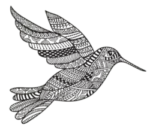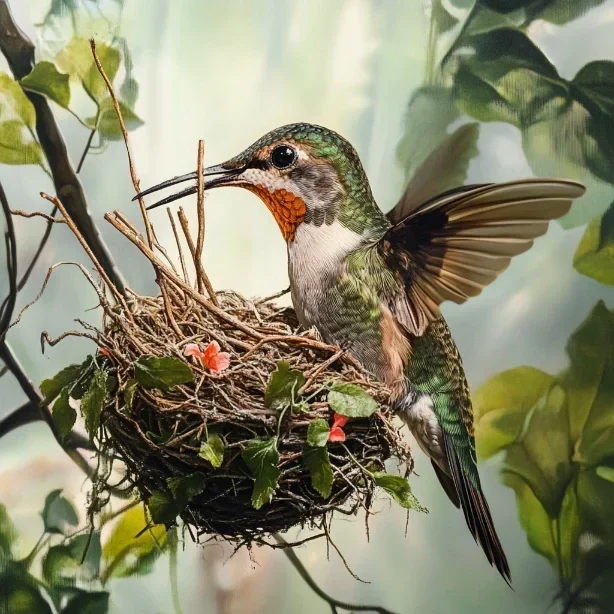(Or: How to Build a High-Rise Studio Apartment Using Spider Silk)
If architects were to study hummingbird nests, they might need to revise their understanding of structural engineering. These tiny builders create homes that combine flexibility with durability, and elasticity with strength, all while maintaining perfect camouflage. Using materials no larger than human hair, they construct expandable nurseries that can withstand wind, rain, and the growing demands of developing chicks.
The Master Plan
Every hummingbird nest begins with careful site selection. The female builder (for it is always the female who constructs the nest) must consider multiple factors: protection from weather, distance from food sources, safety from predators, and structural support requirements. The chosen location might be a slender branch, a sheltered nook, or even, in our modern world, a convenient loop of wire or chain.
Their site selection criteria demonstrate remarkable foresight:
- Protective overhead coverage when possible
- Adequate ventilation and drainage
- Strong structural support
- Strategic distance from other nests
The Construction Materials
Like any skilled builder, hummingbirds are extremely particular about their construction materials. The foundation of every nest relies on spider silk – nature’s most elastic strong fiber. This remarkable material allows the nest to expand as chicks grow while maintaining structural integrity.
The basic building materials include:
- Spider web silk for binding
- Plant down for insulation
- Lichen for camouflage
- Small twigs for structural support
The genius lies in how these materials work together. Spider silk provides both adhesive and elastic properties, allowing the nest to stretch to accommodate growing chicks without losing its shape. Plant down creates a soft interior while providing crucial insulation. Lichen and small bits of bark on the exterior help the nest blend perfectly with its surroundings.
The Building Process
Construction typically takes 6-10 days, with the female making hundreds of trips to gather materials and shape her tiny home. The process demonstrates remarkable precision and planning, beginning with a secure foundation and building upward with careful attention to both structure and comfort.
The sequence follows a precise order:
- Platform construction using spider silk anchors
- Wall building with progressive layers
- Interior lining with soft materials
- Exterior camouflage application
Each trip to gather materials takes into consideration the specific needs of that construction phase. Early trips focus on structural materials, while later ones prioritize soft lining materials for the interior.
The Engineering Marvel
The completed nest represents a triumph of natural engineering. Typically about the size of half a walnut shell, it can stretch to more than twice its original size without losing structural integrity. The walls remain waterproof while allowing proper ventilation, and the entire structure maintains perfect balance despite its diminutive anchor points.
Key engineering features include:
- Flexible yet strong construction
- Effective water management
- Temperature regulation
- Growth accommodation
The Maintenance Phase
Once construction is complete, the work isn’t over. The female continues to maintain and repair the nest throughout its use, adding materials as needed and ensuring structural integrity as the chicks grow.
Maintenance activities include:
- Regular structural reinforcement
- Drainage system clearing
- Camouflage updating
- Size adjustments for growing chicks
The Urban Adaptation
Modern hummingbirds have demonstrated remarkable creativity in adapting their nest-building techniques to urban environments. They’ve learned to incorporate human-made materials and take advantage of artificial structures, all while maintaining the basic principles of their ancestral architecture.
Urban innovations include:
- Use of dryer lint and artificial fibers
- Attachment to man-made structures
- Adaptation to artificial lighting
- Novel camouflage techniques
The Weather Challenge
These tiny architectural wonders must withstand everything nature throws at them, from driving rain to strong winds. The engineering principles employed in their construction allow them to flex without breaking and shed water while maintaining internal temperature.
Weather resistance features include:
- Aerodynamic shaping
- Natural drainage channels
- Flexible support structures
- Insulating layer systems
Conclusion: Nature’s Tiny Architects
The nest-building capabilities of hummingbirds represent one of nature’s most impressive examples of innate engineering. These tiny architects, working with materials barely visible to the human eye, create structures that would challenge our best engineers to replicate at any scale.
Remember: When you discover a hummingbird nest, you’re looking at an architectural achievement that combines the principles of structural engineering, materials science, and environmental design in a package smaller than a golf ball.


